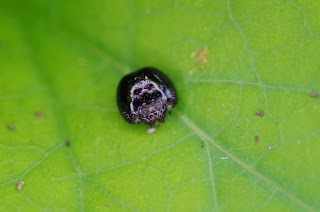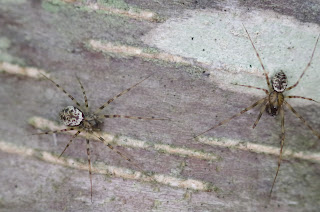I like it better this way. A whole world has opened up to me because I decided at some point to look more closely at the creatures living around me, and to learn more about them. Like that most of them have no reason to sting me, and so they won't, as long as I don't antagonize them. And that many of them are doing things that are good for me, toiling all the time at making nature work. I know they are not doing it for me, or for people in general, that they are just trying to survive themselves, but I am still glad that they are doing it.
Another bug buzzed past my head today, and this one was bigger, and I saw what it was, and was extremely excited to see it. I watched where it went, and followed, so that I could take its picture when it landed. Luckily for me, it landed on the front porch railing instead of high up in a tree. And that is why today I have one of the most amazing bugs I have ever seen as Backyard Bug of the Day:
I thought it was a stick bug. I was very happy and excited all day, thinking that I had finally seen a stick bug. But when I looked it up, for reasons unknown to me, since I thought I already knew what it was, the bug book mentioned that except for a species in Florida (with a picture showing that it was definitely not this bug), North American stick bugs don't have wings. I first saw this flying, so I knew it had wings. Which means this is not a stick bug. But then I didn't know what it was - I looked through to book and found some similar things, but none of them looked quite like this (and they were mostly water bugs). So then I asked online, and was told it is Emesinae (That is the family). So I looked that up, and there it is, in Kaufman's Field Guide to Insects of North America: Thread-legged bug. It is a form of assassin bug, apparently, a sub-family of the assassin bugs.
The two things sticking out in front are not antennae, but legs - if you look closely you can see two other pairs of legs that are where you expect them to be, and you can see the antennae, too, and then those two legs in the front that are used for grabbing prey. So, I have not finally achieved my Bug-it List bug, the stick bug. But this is kind of close, for me, anyway. Because I am not an entomologist, and this is at least a bug that looks like a stick. And watching it fly right in front of my face was pretty cool.
I didn't have to do a bug walk today to find bugs, because last night, well after midnight, I went out on the front porch and found quite a few insects there.
Moths, of course:
This is one of the few moths I actually know the name of: Ailanthus webworm moth
Some sort of Hemiptera
I think this is a caddisfly
I think this is some kind of rove beetle.
Cranefly missing 1/3 of its legs
Not a rhinoceros beetle, I don't think, but it has a tiny rhinoceros-like horn.
I did a bug walk anyway, because... I have to. There was a bit of raindrop dodging - it began to rain while I was photographing the thread-legged bug, and so I went inside when it flew away - but when there was a rain-intermission, I went back out again and found lots of Random Bugs:
The bees and wasps were out in force again today on the goldenrod. I think this is the only one that I got a picture of.
Cricket I found under the rain gauge as I emptied out the less-than-a-half-inch of rain we got from former-Hurricane Hermine yesterday.
I think this is one of the species of moths that come from case-bearing caterpillars.
I think this is a fungus beetle, possibly Endomychus biguttatus. It just looks like a ladybeetle.
Lots of White hickory tussock moth caterpillars around today. They had two popular behaviors today; on was molting:
I happened to find one that had just shed its skin (I was too late to see the actual molting process. I have only seen that once, with a monarch caterpillar).
It looks very wet, and I don't think it's from the rain.
When caterpillars shed their skin, the skin is soft, so they sort of shimmy out of it, leaving it behind. But the caterpillar's face is a harder material. Here you can see the newly-molted face is white, while WHTMCs have black faces normally. Well, on a leaf underneath where this caterpillar molted...
The shed faceplate (I know that has a scientific name, but I don't know what it is).
Here's how it looked a couple of hours later.
The other behavior for WHTMCs was hanging around upside-down on leaves:
They weren't all doing it:
Some just did their own thing. It was just notable to me because usually I see most of them on tree trunks.
You may have noticed in the pictures I have been posting lately of sawfly larvae that they are changing appearance. When this was the BBotD a few days ago, it was white.
Some in various instars. You can see a shed skin on the upper part of the leaf.
A couple of the milkweed bugs have made it to adulthood, so the question is finally answered: Are they large milkweed bugs, or small milkweed bugs?
Small. Identified not just by their size, but the marking on their backs. The small milkweed bug has that black heart marking.
Moth on goldenrod. There was a time in my life when I thought that just bees pollinated plants. I had no idea what really goes on in the natural world.
Leaf-footed bug
Wasp. I don't know what it's eating.
Arachnid Appreciation:
.
.
.
.
.
.
.
.
.
.
.
.
Jumping spider
Flower crab spider, with fly prey, on daisy fleabane
Another flower crab spider, with fly prey, on goldenrod
I think this is a female (left) and male (right).
Female
Male
A pair of daddy-long-legs, male on the left, and female on the right. They were just sitting there, unlike the pair from yesterday.

























































No comments:
Post a Comment